Winter-hardy
Winter-hardy rhododendrons are able to survive in cold climates and frosts (they tolerate the winter of northern regions well). A strong root system and tough leaves help them withstand harsh conditions. But proper care, which involves providing reliable protection from the wind, regular fertilizing and watering, can significantly increase their winter hardiness.
The Hague
Represented by a group of hybrids obtained by crossing different species. Bred in 1974 in Finland, but is widely grown in many countries around the world. It can grow in various latitudes, but prefers a moderate climate with cool summers and mild winters. It is considered a winter-hardy variety and tolerates air temperatures down to -20°C. Overwinters without shelter.
Rhododendron “The Hague” is a fast-growing shrub up to 1.5 meters high and up to 1.2 meters wide. It has a dense crown with dark green wavy leaves up to 15 cm long, many strong roots (the root system is powerful).
During the flowering period, which begins in mid-spring and ends in June, large purple-pink flowers with red spots on the petals bloom on it (in the photo). They have the shape of a neat funnel with wavy edges, collected in large inflorescences.
Planting of rhododendron “The Hague” is carried out in acidic loose soil. The bush does not tolerate bright spring sun, so it should be planted in partial shade or shade. Despite the small amount of light, it blooms well.
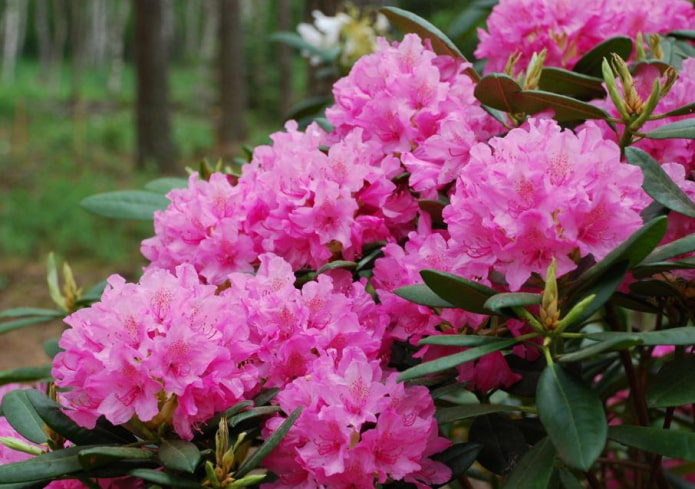
University of Helsinki
This is a hybrid variety, bred in 1974 in Finland and named in honor of the 350th anniversary of the university of the same name. Prefers a moderate climate, grows well in USDA zones 4-7 with a minimum winter temperature of -34 … -12 ° C. However, it can withstand stronger frosts, typical for USDA 3 (it tolerates the harshest winter). Therefore, it is compatible with plantings in cold climates.
The plant is a shrub up to 1.7 m high. The shrub is densely covered with leaves, the crown span is about 1.5 m. It has a strong root system. Flowering begins in early June, at this time large purple-pink buds (in the photo) with a pleasant aroma are formed on the plant. There are red specks in the upper part of the petals. The flowers are collected in lush inflorescences up to 15 cm in diameter.
The variety prefers acidic soils with a pH of 4.5-6.5. It tolerates high humidity well, but does not like direct sunlight. It grows better in partial shade or with frequent changes in lighting. It likes peat fertilizing. It is necessary to prune in autumn.
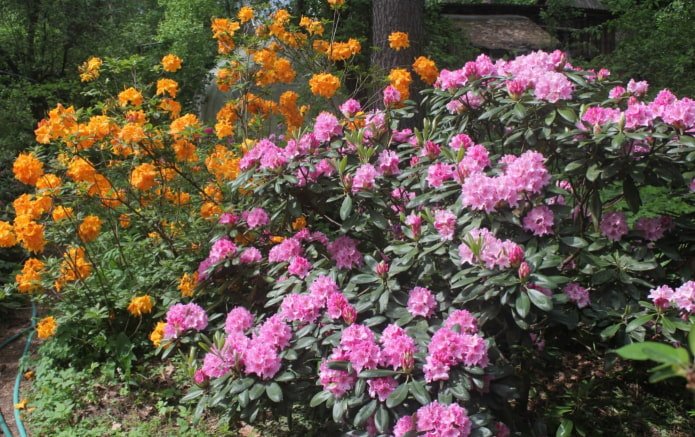
Rhododendron “Catewbinsky grandiflorum”
A fast-growing evergreen shrub, bred in the mid-19th century in the USA. It is one of the first varieties brought to Europe. It tolerates the cold winter of temperate latitudes well.
The shrub is large and spreading: it reaches a height of 3-4 m and a width of 5 meters. Covered with a dense crown formed by elliptical green leaves about 8 cm long. Flowering begins in May: simultaneously with young leaves, funnel-shaped flowers of a lilac hue with bright orange inclusions (stripes) in the center appear on the bush (in the photo). Flowers are collected in inflorescences of 12-15 pieces. Combines with any plantings.
For successful cultivation of the rhododendron “Katevbinsky grandiflorum” it is recommended to choose for it a place with a semi-shady or shady microclimate, protected from direct sunlight and drafts. The soil should be acidic, fertile and well-drained. The plant requires regular watering and fertilizing with peat, especially during the period of abundant flowering. Pruning is essential.
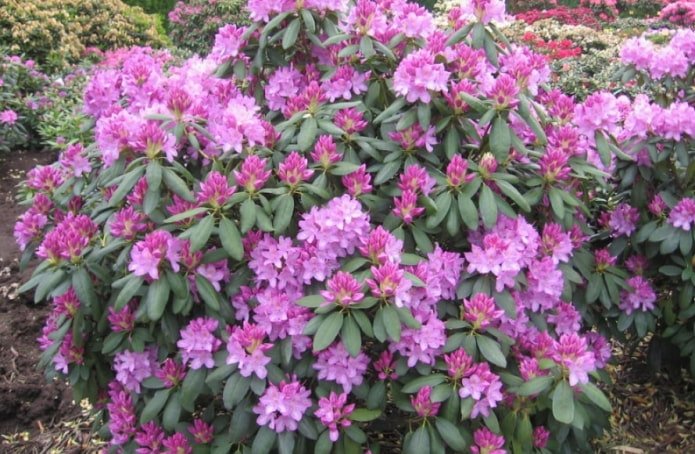
Rhododendron “Carolina PJM Elite”
Bred in the late 1980s in the USA and named after the famous American breeder Peter J. Mesitt. It is one of the most winter-hardy varieties and can withstand temperatures down to -29°C, making it suitable for growing in most regions with moderate and cold climates. It has a very bright, expressive appearance, due to which it received popular names: alpine rose, wild rosemary, mountain datura.
The plant can reach a height and width of up to 1 m. It has a dense, thick crown formed by large elliptical leaves. At first they acquire a chocolate shade, as they develop they become dark green, and by autumn they acquire a bronze coating (in the photo). Flowering begins in late spring and continues for a month (ending in June). Flowers can be of various shades – from lavender to dark pink. Combines with any plantings.
Like most varieties, the rhododendron “Carolina PJM Elite” is best planted in acidic and loose soil. It does not tolerate drought and requires regular watering, but it should not be over-moistened either. Prefers additional feeding, for example, peat.
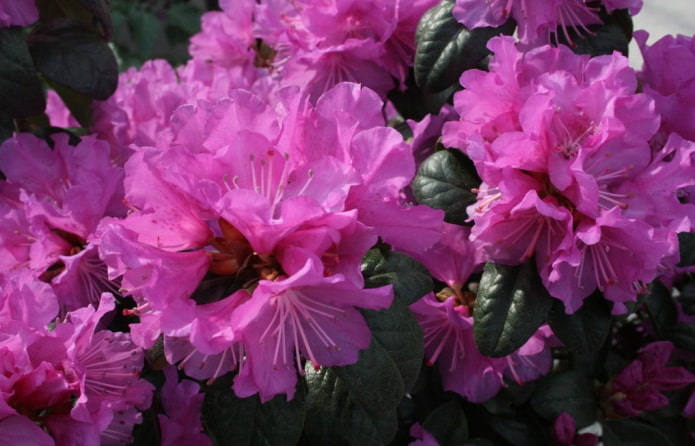
Evergreen
Evergreen rhododendrons retain their leaves all year round, which determines their popularity in landscape design (they are planted in garden plots near houses). As a rule, they are drought-resistant and shade-tolerant. With proper care, they bloom annually, covered with a thick cap of bright flowers.
Lipnice
A representative of evergreen rhododendrons, “Lipnice”, was bred by the Czech breeder Jan V. Blecha in the 1970s. Obtained by crossing several species, including Rhododendron racemosum, Rhododendron mucronulatum and Rhododendron dauricum. Belongs to the Lepidote group of small-leaved rhododendrons.
The height of the bush does not exceed 1.5 m, its branches are densely covered with leaves. It has many strong roots. During the flowering period, dark purple buds appear on young shoots (in the photo), which soon bloom and exude a pleasant aroma. The plant goes well with any plantings.
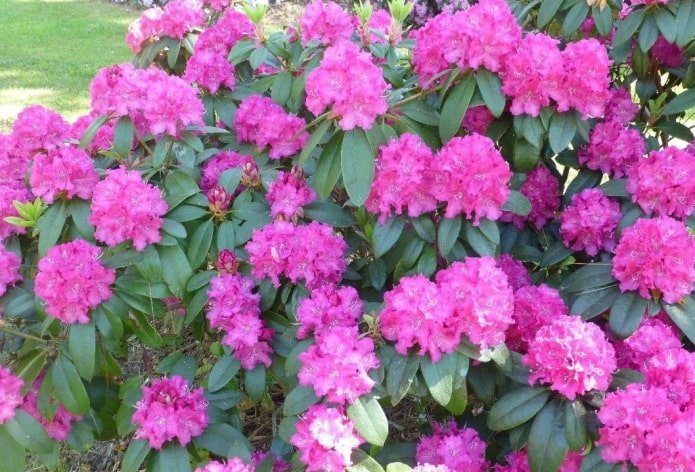
Karens
The evergreen rhododendron “Karens” was bred in 1979 by the American breeder R. Amstutz. It is a hybrid obtained by crossing the species Katawbiense and Maximum.
Rhododendron “Karens” is distinguished by the presence of very strong roots and large flowers (in the photo), which can be pink, red or white, as well as a crown with small leaves and a compact bush shape. It is a popular plant for creating hedges and is used in landscape design to place bright accents on garden plots. By choosing different shades, you can alternate the bushes in stripes. In order for the plant to develop well in the garden, you need to strictly follow the rules of care.
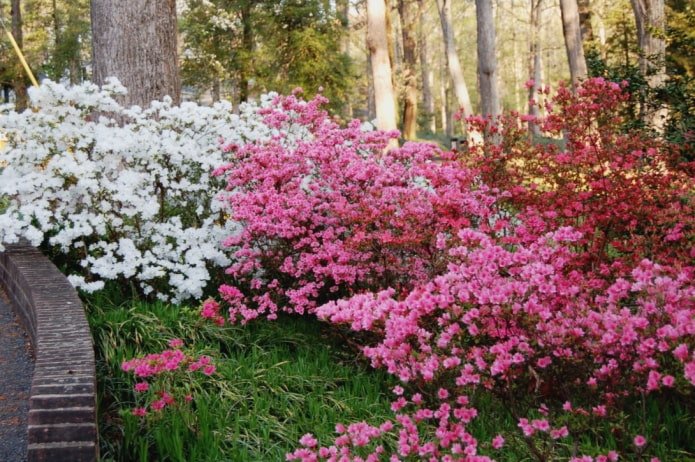
Marcel Menard
This evergreen variety was bred by the French breeder J. Julien in the 1880s. It was obtained by crossing the species Rhododendroncatawbiense and Rhododendronarboreum. Belongs to the group of large-leaved rhododendrons.
It is a large-leaved evergreen bush (in the photo), which can reach a height of 3 m and a width of 2.5 m. It has many strong roots. Its leaves are large, dark green, have an oval shape. The flowers are quite large, about 10 cm in diameter. They can be pink, red or white, with dark spots on the upper side of the petals.
The evergreen Marcel Menard blooms in late spring and lasts until early summer. It goes well with any plantings in the garden (or elsewhere).

Erato
This representative of the evergreen rhododendrons appeared in 1837 as a result of the long-term work of Belgian breeders. It was obtained by crossing the Maximum rhododendron and the Catawbiense rhododendron. Named after the ancient Greek muse of poetry, Erato.
The evergreen bush is quite tall, its height can be 1.4 m. Rhododendron “Erato” is distinguished by many strong roots, large wine-colored flowers; each petal has a dark red spot. It is combined with any plantings, in any place of the site.

Deciduous
Deciduous rhododendrons lose their leaves in winter. Their popularity is primarily due to their decorative properties: beautiful flowering and bright autumn color. Such plants are more frost-resistant than evergreen varieties.
Mandarin Lights
The deciduous rhododendron “Mandarin Lights” was bred by the American breeder G. Davis in 1955. It got its name due to its bright orange flowers and light green foliage (in the photo). The bush is quite compact. The variety still remains popular among gardeners due to its high decorativeness and resistance to diseases and pests.
In order for the plant to develop well, it is necessary to strictly follow the rules of care (choosing a location, planting dates, watering, pruning, etc.). The deciduous shrub likes acidic soils; in other places it will develop poorly or die.
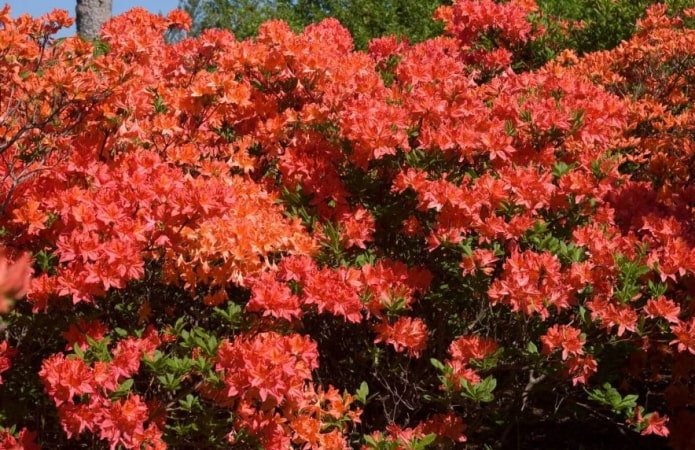
Azalea Vasea
This variety was bred by the American F. Gumbel in 1935. It was named after W.M. Vasea, a botanist who studied the flora of the southeastern states of the United States, where this plant grows. Azalea “Vazeya” is distinguished by large, bright pink flowers and shiny green foliage. It is one of the most popular varieties of azaleas due to its beauty and resistance to diseases and pests. Prefers acidic soils.
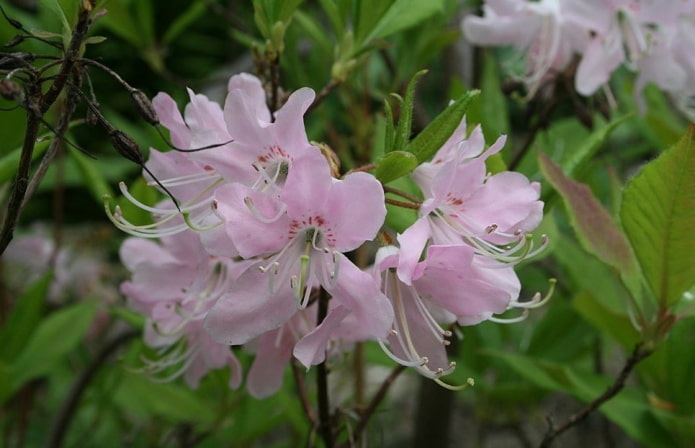
Oxydol
The deciduous rhododendron Oxydol was bred by the American breeder G. Davis in the mid-20th century. He was one of the most famous breeders of rhododendrons in the USA. The variety got its name due to its white flowers with bright red spots on the edges of the petals, reminiscent of Oxydol paint stains. Prefers acidic soils.
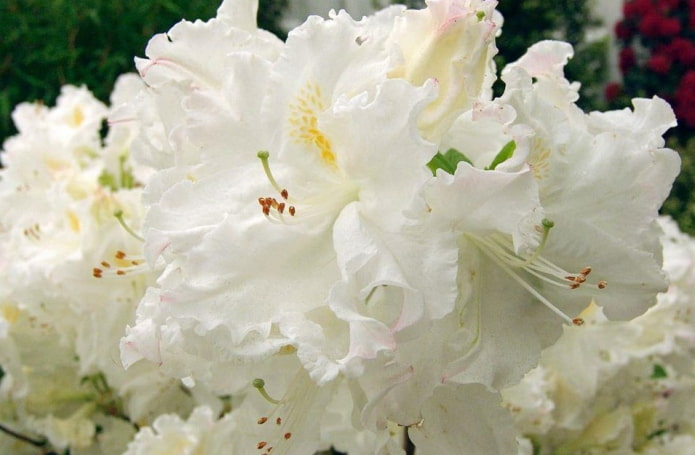
Yedoensky F. Pukhkhansky
This is a hybrid variety bred by the Japanese breeder Hiroshi Takahashi in the 1970s. It was obtained by crossing the rhododendrons – “Yedoensky” and “Pukhkhansky”. The bush grows in many countries, including Japan, China, Korea and Russia. In Russia, this variety of rhododendron can be seen in the N.N. Alexandrov in Moscow, as well as in other botanical gardens and parks.
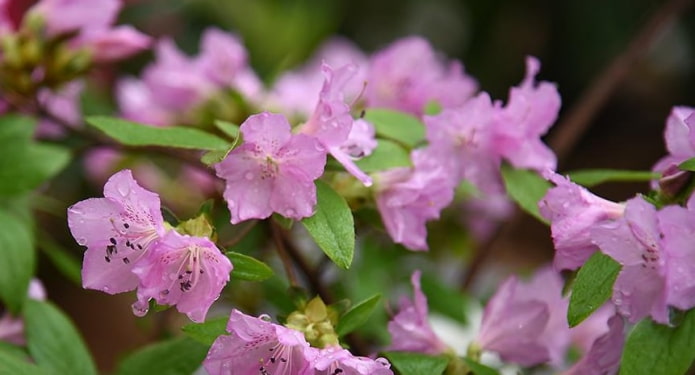
Varieties by color
There are varieties of rhododendrons with flowers of different shades, including white, yellow, orange, pink, red, purple, and even blue. Sometimes the bud has a variegated color.
Red
Red rhododendrons are among the most popular varieties of the plant. They attract attention with large expressive flowers of bright or dark shades. They are very popular among gardeners, because the flowers from flower buds begin to bloom mainly in spring or early summer (in June). They are also often preferred by fans of Japanese culture, since the red color has many symbolic meanings in Japanese culture and is present on various pieces of art: paintings, kimonos, etc.
Red rhododendrons are represented by many varieties, which makes it easy to select a plant depending on the growing conditions and aesthetic preferences of the gardener. The most popular varieties include the following:
Nova Zembla
The variety was bred in the 1960s in the Netherlands and is a hybrid of several types of rhododendrons. It can be grown in most regions of Russia, but in the north you will have to create a shelter for the winter.
Rhododendron Nova Zembla is a bush with a dense, rounded crown. The bush reaches a height of 2 m. Its leaves are large, dark green and elliptical. The flowers have an incredibly beautiful ruby-red color with a black spot on the upper petal. Collected in lush inflorescences.

Balalaika
The “Balalaika” variety belongs to slow-growing low bushes. It develops well in moderate and cold climates. Its popularity among gardeners is due to the compactness of the bush, beautiful foliage and abundant elegant flowering.
The growth (height) of the bush is only 60 cm. However, its crown is thick and dense, formed by simple leaves of dark green shades. Flowering periods occur in late spring – early summer (in June). The flowers have a bright orange-red color, which becomes reddish-pink at the edges of the petals. In the center of each blossoming bud there is an orange-yellow spot.
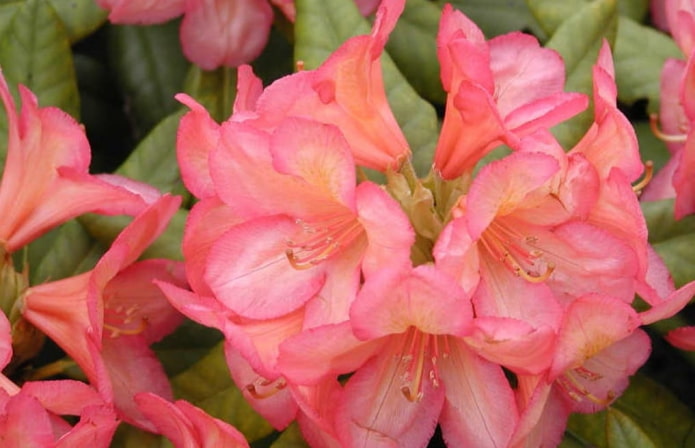
Yellow
Yellow rhododendrons are rare varieties. They grow mainly in the northern regions of America and Asia, in some parts of Europe. Most of them are sensitive to drought and low temperatures, prefer shade and fertile soils with a good drainage system. The most popular yellow rhododendrons include:
Lemon Dream
This variety was bred in 1985 by the American breeder G. Dale from Oregon. He received this variety by crossing the rhododendrons Goldfort and Lem’s Cameo.
The bush usually grows to no more than 1.5 m. It has a dense spreading crown up to 1.2 m wide, formed by green elliptical leaves. The flowers of the plant are very beautiful, they have a funnel-shaped form and an expressive pale yellow color.
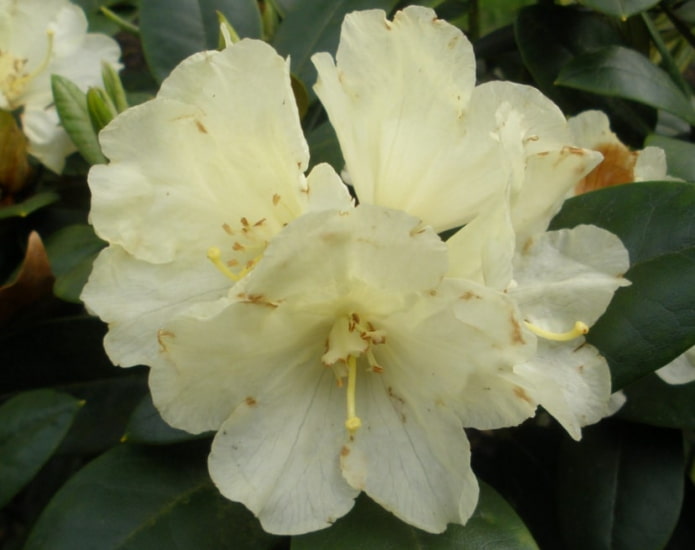
Yellow Hammer
The variety was bred in the UK in the 1970s by breeder D. Hope. It was obtained by crossing the rhododendrons Goldsworth Yellow and Fabia. The Yellow Hammer rhododendron quickly became popular due to its large yellow flowers and compact bush size. Today, this variety can be found in many gardens and parks around the world.
This is a bush about 1.5 m tall with a spreading dark green crown. It blooms very beautifully: in May, light yellow tubular buds bloom on the shoots.

Cool shades
This category includes rhododendrons of cool shades: from blue to purple. These are rare and unusual flowers that can decorate any garden. But they are often difficult to grow: they need to be planted in acidic soil, maintain a strictly defined level of humidity, and protect from bright light. Among the plants in this category, the most popular are:
Maggie
This is a hybrid variety from the American breeder G. Davis, bred in the 1950s. It grows in many countries, including the USA, Great Britain, Canada, and other countries with a temperate climate. Rhododendron “Maggie” is not one of the most popular varieties of rhododendrons in Russia, but it can be found in some botanical gardens and private gardens. Prefers acidic soils.
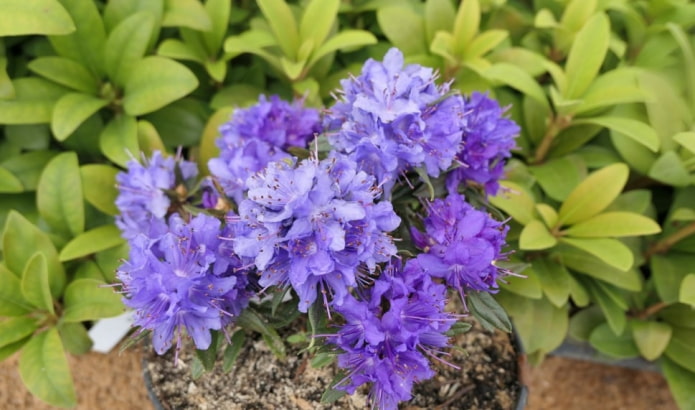
Moerheim
Rhododendron Moerheim is a hybrid variety bred by the Dutch breeder J. Mulder in the 1930s. It grows well in a moderate climate. In Russia, it can be grown in gardens and parks, but for this it is necessary to create certain conditions, since this variety of rhododendron must be planted in acidic soil and provide conditions characteristic of a moderate climate.
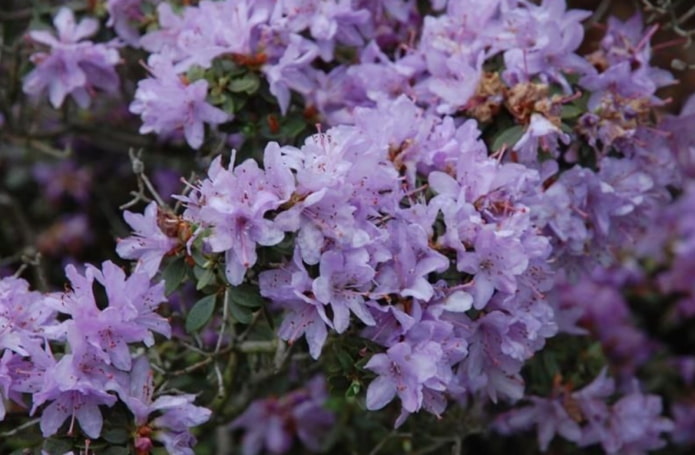
Varieties by size
Rhododendrons can have different sizes: from dwarf to giant. Their growth depends on the variety and growing conditions. Small species can reach a height of only 30-40 cm, large ones – up to 10 m. Most varieties that are grown in gardens have sizes from 1 to 3 m in height and width.
The largest
Rhododendrons of this group are distinguished by the large size of their bushes and flowers. The height of some of them can be up to 10 m, and the size of the flowers – up to 30 cm. The largest varieties include:
Giant Rhododendron
This rhododendron grows in the mountainous regions of Bhutan and China, at altitudes from 2400 to 4800 m. It is considered one of the largest plants of the genus and is a symbol of the Himalayas.
The height of the tree (bush) can reach 30 m, has a dense crown with dark green leaves. Flowering time falls at the end of spring (May-June). During this period, buds of white, pink, red shades bloom from the buds on the branches of the tree. The flowers are very large and reach 30 cm in diameter. Prefers acidic soils.
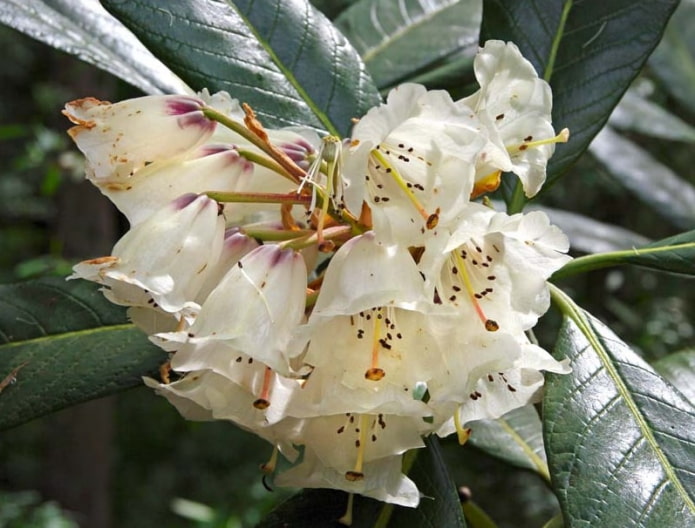
Pontic Rhododendron
This species has been known since the 18th century, when it was first described by the Swedish botanist K. Linnaeus. Pontic Rhododendron grows in the mountainous regions of the Caucasus, the Balkans and Turkey. In the wild, the tree grows in forests, on mountain slopes and in rocky areas.
The tree usually reaches 5 m in height, rarely 8 m. It has a dense crown and dark green leaves, the length of which can be up to 25 cm. The flowers are large (about 6 cm in diameter), have different shades: purple, pink or white. Flowering begins in April and continues until June.
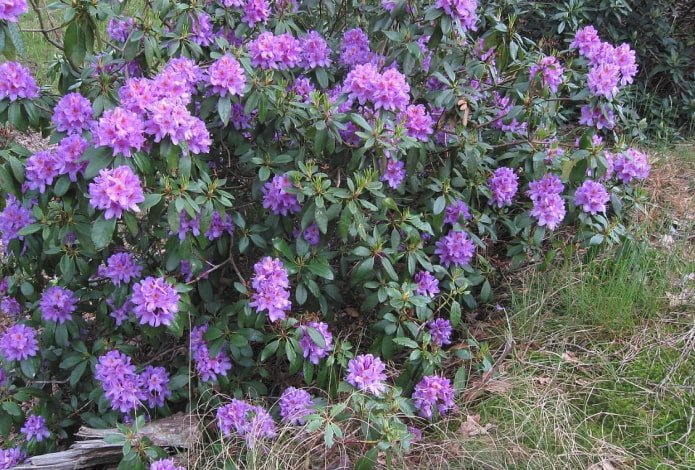
Gibraltar
This hybrid variety was bred in the late 1970s by American breeders. It grows best in USDA zones 6-9, withstanding temperatures down to -23°C and light frosts (otherwise it needs shelter). It is very popular among gardeners in the southern regions due to its beautiful dense crown and abundant flowering. Such rhododendrons grow well with careful care.
The height of the plant can reach 2 m. It has a spreading crown, densely covered with leaves. During the flowering period, which begins in May, large bell-shaped flowers bloom on young shoots from the buds. Usually their diameter does not exceed 8 cm. They have a bright orange-red color. Prefers acidic soils.
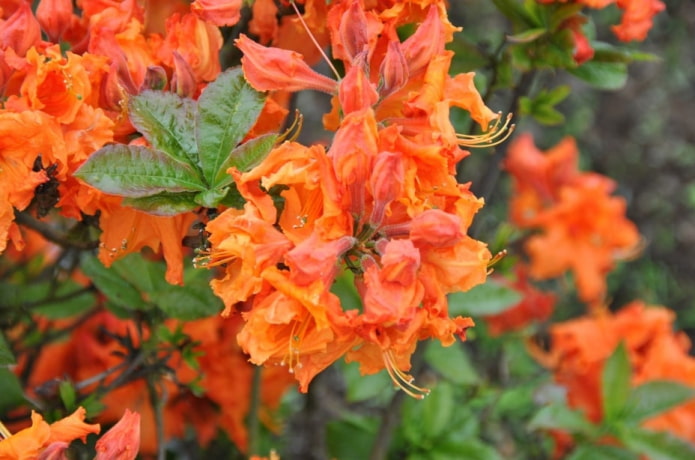
The Smallest
Among the rhododendrons, there are low-growing species that are distinguished by the small size of their bushes and flowers. The height of some of them can be less than 1 m, and the size of their flowers is less than 3 cm. These include:
Rhododendron Chonoski
This low-growing species was first described in 1871 by the Russian researcher K.I. Maksimovich. It grows on the Kuril Islands, mainly on mountain slopes.
The height of the bush is no more than 1.2 m. The branched plant has a dense crown formed by many small dark green leaves, dotted with rusty hairs. It begins to bloom in July, at this time buds with white petals bloom on it. Flowers are small and do not exceed 1 cm in diameter.
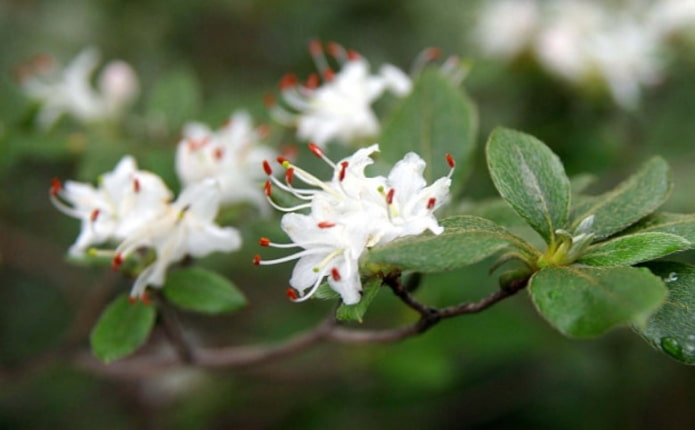
Rhododendron Kamchatka
This is one of the oldest species, grown in culture since 1784. In the natural environment, it is widespread on the territory of the Kamchatka Peninsula, Sakhalin Island, and Khabarovsk Krai. It is widely used in landscape design, very often planted in rock gardens, in garden plots. It is winter-hardy.
It is a small deciduous shrub, the height of which is no more than 35 cm. There are specimens only 4 cm tall. It begins to bloom in May, at this time buds of different shades are formed on the shoots: white, pink, red.
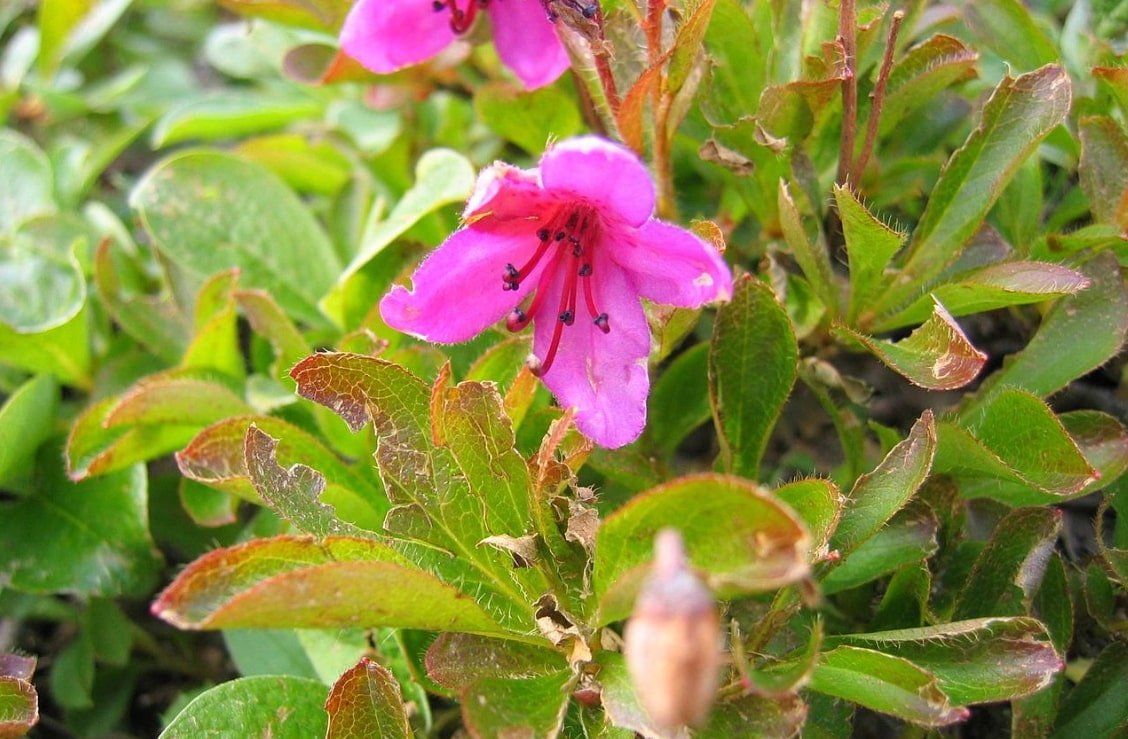

Rhododendron Kermesina
This species was first described in the middle of the 18th century by the famous Swedish naturalist K. Linnaeus. It grows in the mountainous regions of South Asia, including the Himalayas and Tibet.
Usually the height of the bush does not exceed 60-80 cm. It has a thick dense crown formed by small dark green winter leaves. It begins to bloom in May-June: many small flowers of ruby-red, less often pink and white shades bloom on its young shoots.

Which varieties are suitable for different regions
For northern regions, where winters are cold and long, rhododendron varieties that have high winter hardiness are suitable. Some of these varieties include:
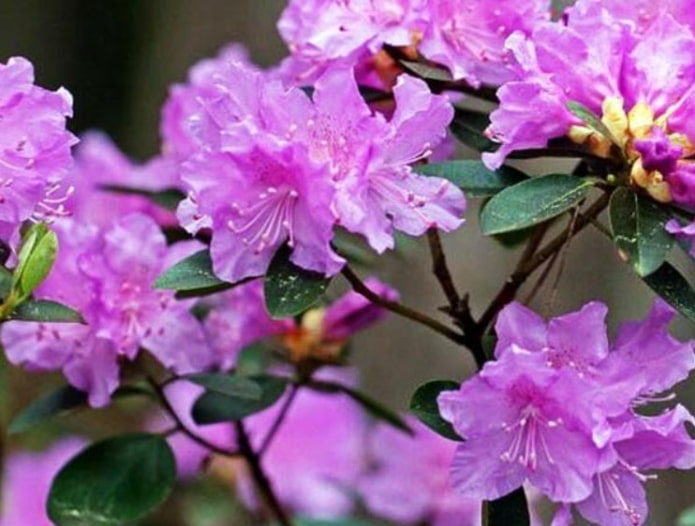
PJM Regal
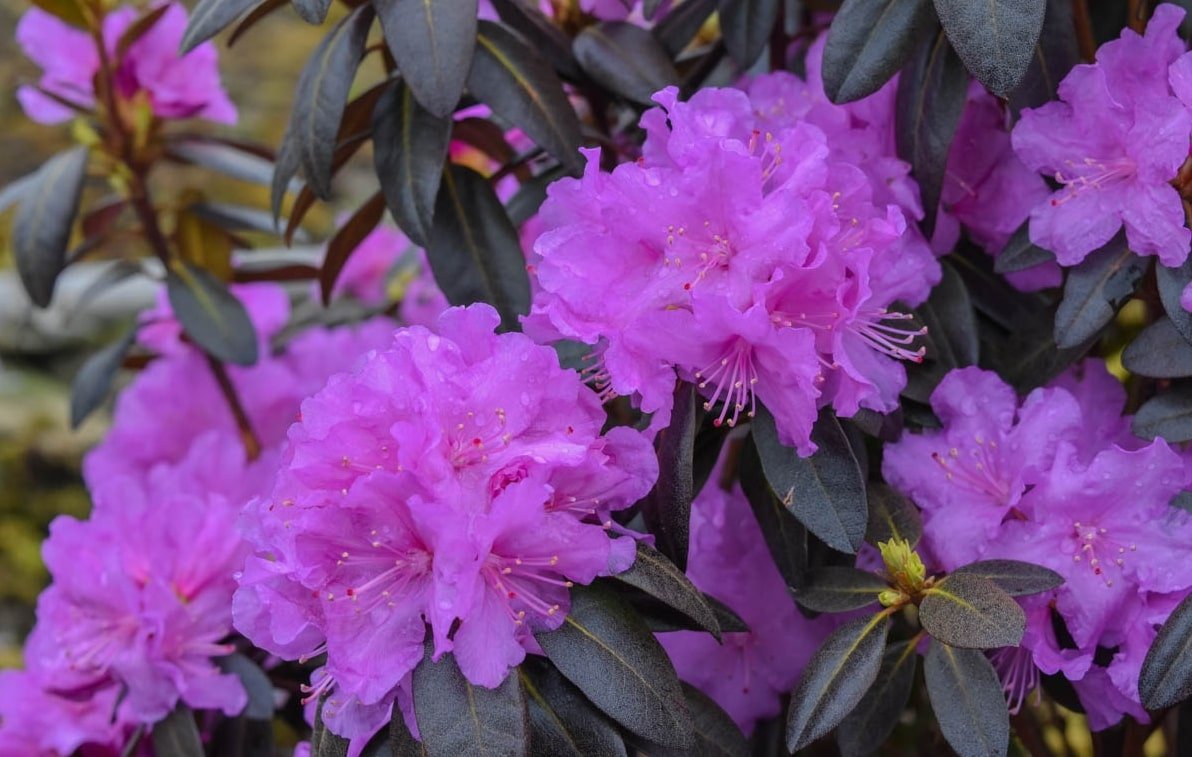

PJM Compacta
Rhododendrons are typically found in northern regions where the climate is cool and the soil is acidic. But there are several varieties that can survive in southern regions with warmer climates. For example, such plants include:
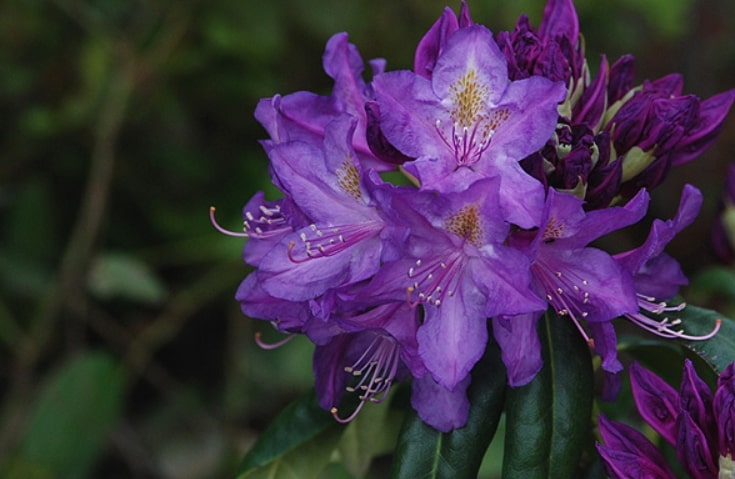

Lee’s Dark Purple
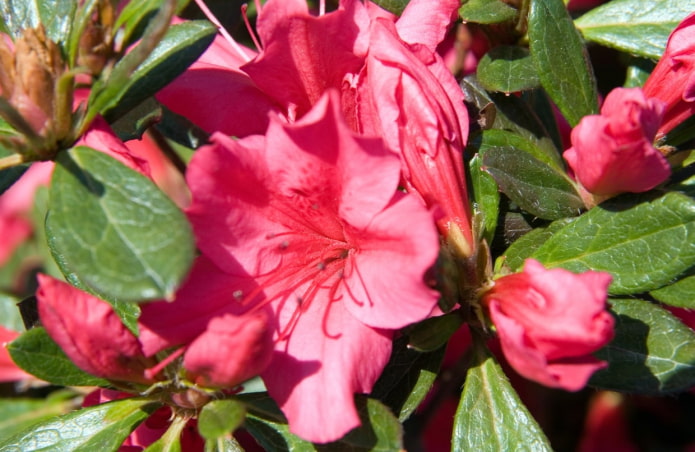
Girard’s Rose
For the Siberian and Ural regions, varieties that tolerate cold winters and short summer periods are suitable. For example, these include:
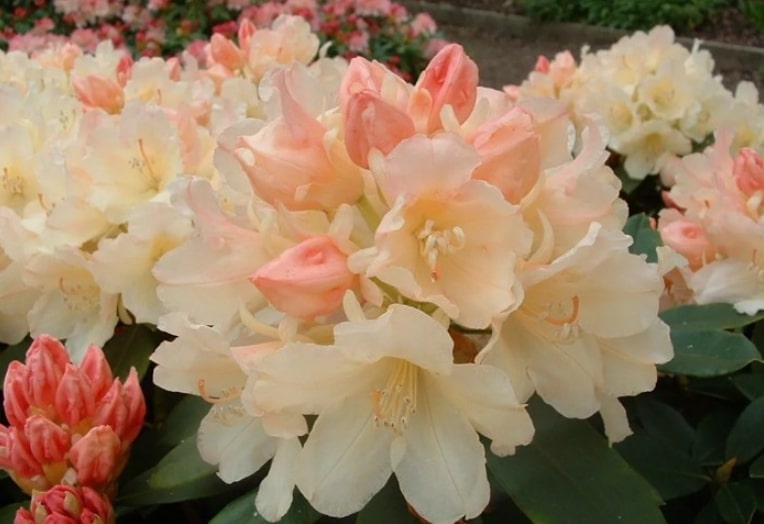

Golden Torch


Roseum Elegans

Japanese Rhododendron
Rhododendron varieties that can survive in a moderate climate and less acidic soil are suitable for the central region of Russia. As an example, several species can be given (shown in the photo):
English Roseum
Boursault
Now reading:
- Discover the All-New Mazda 3: Style Meets Performance
- Create your own organizer: 12 easy steps with pictures and video.
- Making a banquette for the hallway with your own hands: 3 master classes and 10 ideas.
- Loft style ceiling: more than 60 photos and current design ideas.
- Liquid wallpaper: photos of artistic drawings and designs on walls